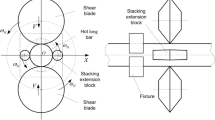Abstract
Ultra-large plate forgings are foundation of heavy machinery, but many parts of the type cannot be made by conventional technologies due to the characters of extreme manufacturing in terms of size and quality requirements. This paper introduced a systematically method called cylinder unfolding method (CUM) for producing large plate forgings, by using a serial of operations including “splitting”, “unfolding”, and “flattening” of a thick cylinder obtained from saddle forging. The technological route of CUM was presented in detail with an example of plate forging with the horizontal sizes of 6100 mm and thickness of 300 mm. The deformation features of saddle forging for fabricating transitional cylinders were analyzed, and then the subsequent handling steps including splitting, unfolding and flattening of the cylinder, as well as the auxiliary processing, were addressed. The practice proved that CUM can provide an efficient way for manufacturing ultra-large plate forgings and meet the strict requirements in geometry and mechanical performance, without highly increasing the investments of forming equipment and tooling.
摘要
超大型平板锻件是重型机械工业的基础,但由于其在尺寸和质量要求方面具有极限制造的特点, 许多类型的零件无法采用传统方法制造。本文系统介绍了一种称为筒体展开法(CUM)的方法,可以通 过对马杠扩孔得到的过渡厚壁圆筒进行劈开、展开和压平等一系列操作,实现大型板锻件生产。以水 平尺寸6100 mm、厚度300 mm 的板锻件为例,详细介绍了CUM 的工艺路线,分析了圆筒马杠扩孔 过程的变形特点,介绍了筒体劈开、展开与展平等后续处理步骤以及辅助工序。生产实践证明,CUM 提供了一种有效的超大型平板锻件生产方法,可在无需增加设备和模具投资的同时,满足制件几何和 机械性能的要求。
Similar content being viewed by others
References
TSUKADA H, SUZUKI K, SATO I. Ultra-large size austenitic stainless steel forgings for a fast breeder reactor: development, manufacturing and properties achieved [J]. Nuclear Engineering and Design, 1987, 102(3): 495–503. DOI: https://doi.org/10.1016/0029-5493(87)90194-4.
BERGER T, MURAI E, KURIHARA I. Manufacturing and properties of nozzle shell with integral flange for EPR reactor pressure vessel [J]. Iron Making and Steel Making, 2007, 34: 205–210. DOI: https://doi.org/10.1179/174328107X174717.
LIU Guo-hui. Forging technology of heavy plate-shaped forgings [J]. Forging & Stamping Technology, 2005, 2: 4–6. (in Chinese)
JHA A, SREEKUMAR K, THARIAN T. Process optimization for high fracture toughness of maraging steel rings formed by mandrel forging [J]. Journal of Manufacturing Processes, 2010, 12(1): 38–44. DOI: https://doi.org/10.1016/j.jmapro.2010.01.007.
KAKIMOTO H, ARIKAWA T, TAKAHASHI Y. Development of forging process design to close internal voids [J]. Journal of Materials Processing Technology, 2010, 210(3): 415–422. DOI: https://doi.org/10.1016/j.jmatprotec.2009.09.022.
ONODERA S, KAWAGUCHI S, TSUKADA H. Manufacturing of ultra-large diameter 20MnMoNi 5 5 steel forgings for reactor pressure vessels and their properties [J]. Nuclear Engineering and Design, 1985, 84(2): 261–272. DOI: https://doi.org/10.1016/0029-5493(85)90196-7.
ERVE M, PAPOUSCHEK F, FISCHER K. State of the art in the manufacture of heavy forgings for reactor components in the Federal Republic of Germany [J]. Nuclear Engineering and Design, 1988, 108(3): 485–495. DOI: https://doi.org/10.1016/0029-5493(88)90238-5.
FENG Chao, CUI Zhen-shan, LIU Ming-xiang. Investigation on the void closure efficiency in cogging processes of the large ingot by using a 3-D void evolution model [J]. Journal of Materials Processing Technology, 2016, 237: 371–385. DOI: https://doi.org/10.1016/j.jmatprotec.2016.06.030.
LEE Y, LEE S, TYNE C. Internal void closure during the forging of large cast ingots using a simulation approach [J]. Journal of Materials Processing Tech, 2011, 211(6): 1136–1145. DOI: https://doi.org/10.1016/j.jmatprotec.2011.01.017.
FENG Fa-ming. Research on the forging process for heavy wide-thick plate blanks [J]. Heavy Casting and Forging, 1996(2): 20–22. DOI: https://doi.org/10.14147/j.cnki.51-1396/tg.1996.02.005. (in Chinese)
WANG Xin-peng, WEN Tong, LIU Pan. Deformation analysis of large cylinder with mandrel reaming process [J]. Hot Working Technology, 2010, 39(11): 53–56. DOI: https://doi.org/10.14158/j.cnki.1001-3814.2010.11.011. (in Chinese)
SUN Ming-yue, HAO Lu-han, LI Shi-jian. Modeling flow stress constitutive behavior of SA508-3 steel for nuclear reactor pressure vessels [J]. Journal of Nuclear Materials, 2011, 418(1–3): 269–280. DOI: https://doi.org/10.1016/j.jnucmat.2011.07.011.
WEN Tong, LIU Lan-tao, HUANG Qian. Evaluation on prediction abilities of constitutive models considering FEA application [J]. Journal of Central South University, 2018, 25(6): 1251–1262. DOI: https://doi.org/10.1007/s11771-018-3822-8.
MAYER K, BERGER C, GNIRSS G. Investigations by non-destructive inspection to determine the size of natural defects in large forgings of turbogenerators [J]. Nuclear Engineering and Design, 1993, 144(1): 155–170. DOI: https://doi.org/10.1016/0029-5493(93)90017-4.
HASELHOFF W, MAIDORN C, HERINGDORF J. Experience with the fabrication of thick-walled forgings of X5 CrNi 13 4 for the primary circuit of pressurized water reactors [J]. Nuclear Engineering and Design, 1986, 94(3): 211–219. DOI: https://doi.org/10.1016/0029-5493(86)90003-8.
ZHANG Yu-cun, HAN Jun-xia, FU Xian-bin. Measurement and control technology of the size for large hot forgings [J]. Measurement, 2014, 49: 52–59. DOI: https://doi.org/10.1016/j.measurement.2013.11.028.
ARIKAWA T, YAMABE D, KAKIMOTO H. Influence of anvil shape of surface crack generation in large hot forging process [J]. Procedia Engineering, 2014, 81: 480–485. DOI: https://doi.org/10.1016/j.proeng.2014.10.026.
TANAKA Y, SATO I. Development of high purity large forgings for nuclear power plants [J]. Journal of Nuclear Materials, 2011, 417(1–3): 854–859. DOI: https://doi.org/10.1016/j.jnucmat.2010.12.305.
Author information
Authors and Affiliations
Corresponding author
Additional information
Foundation item: Project(cstc2018jcyjAX0159) supported by the Natural Science Foundation of Chongqing, China; Project(51575066) supported by the National Natural Science Foundation of China
Rights and permissions
About this article
Cite this article
Deng, Zh., Wen, T., You, Jh. et al. Manufacturing of ultra-large plate forgings by unfolding and flattening of thick cylinders. J. Cent. South Univ. 27, 2227–2238 (2020). https://doi.org/10.1007/s11771-020-4444-5
Received:
Accepted:
Published:
Issue Date:
DOI: https://doi.org/10.1007/s11771-020-4444-5




